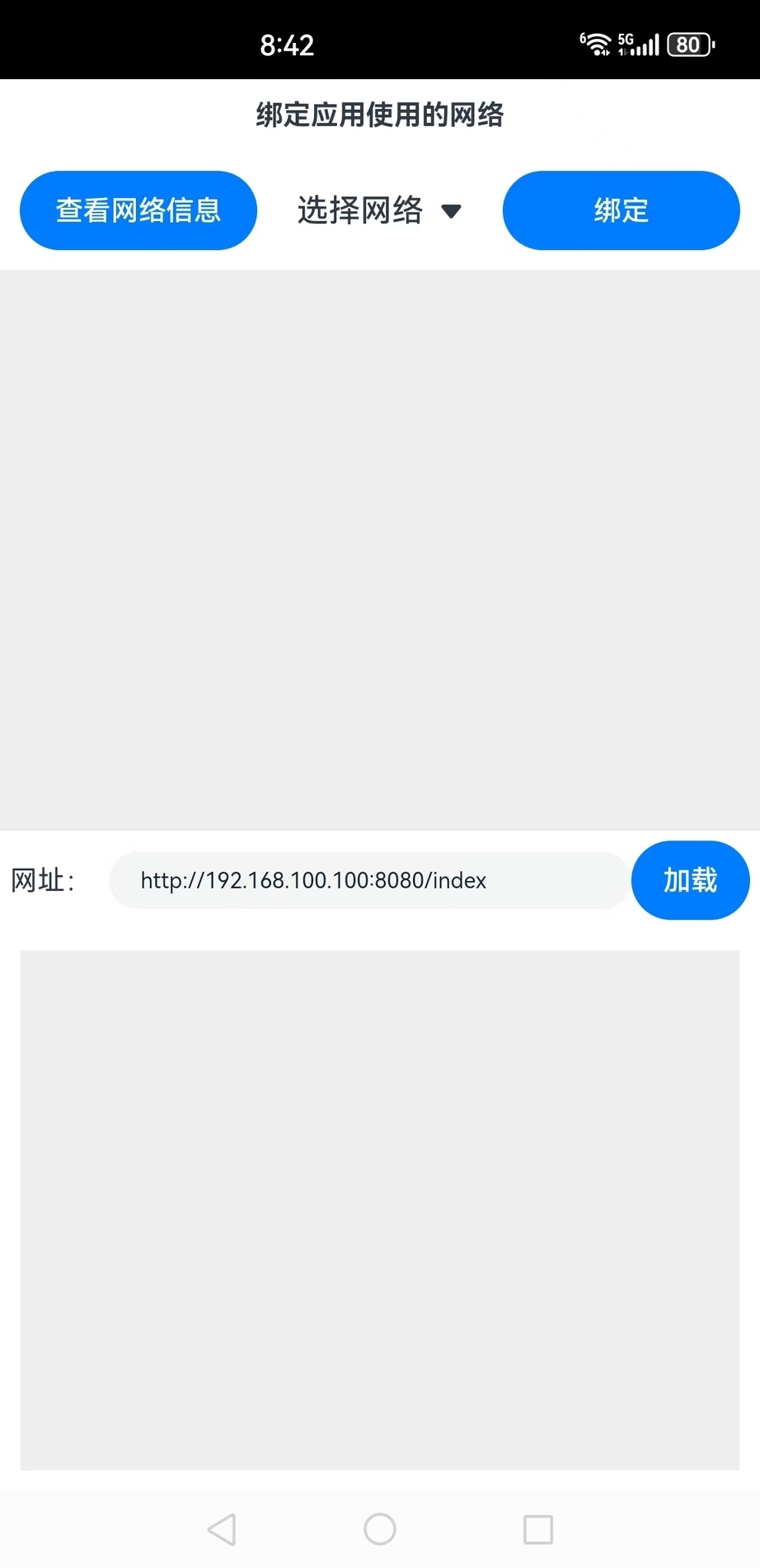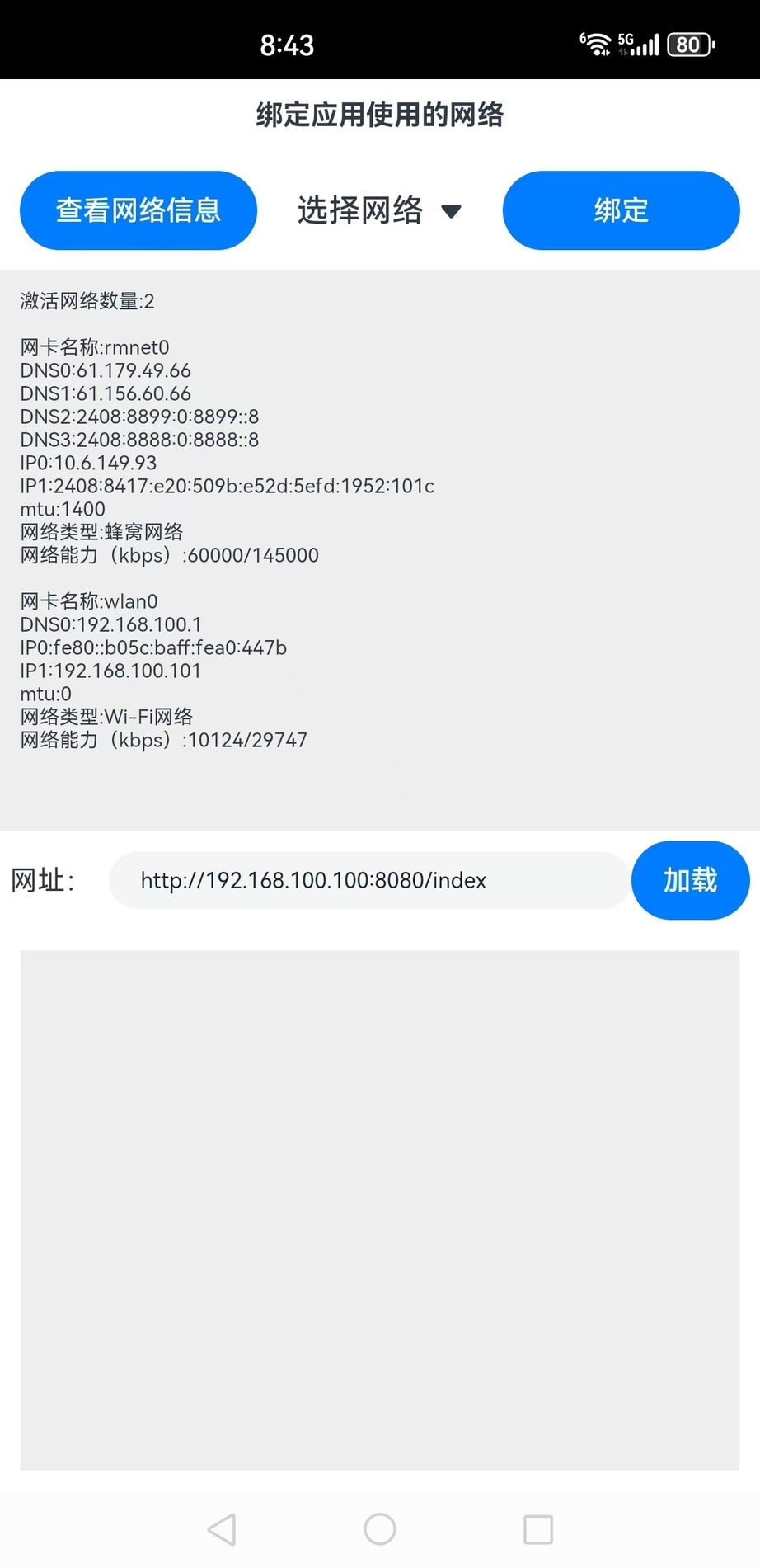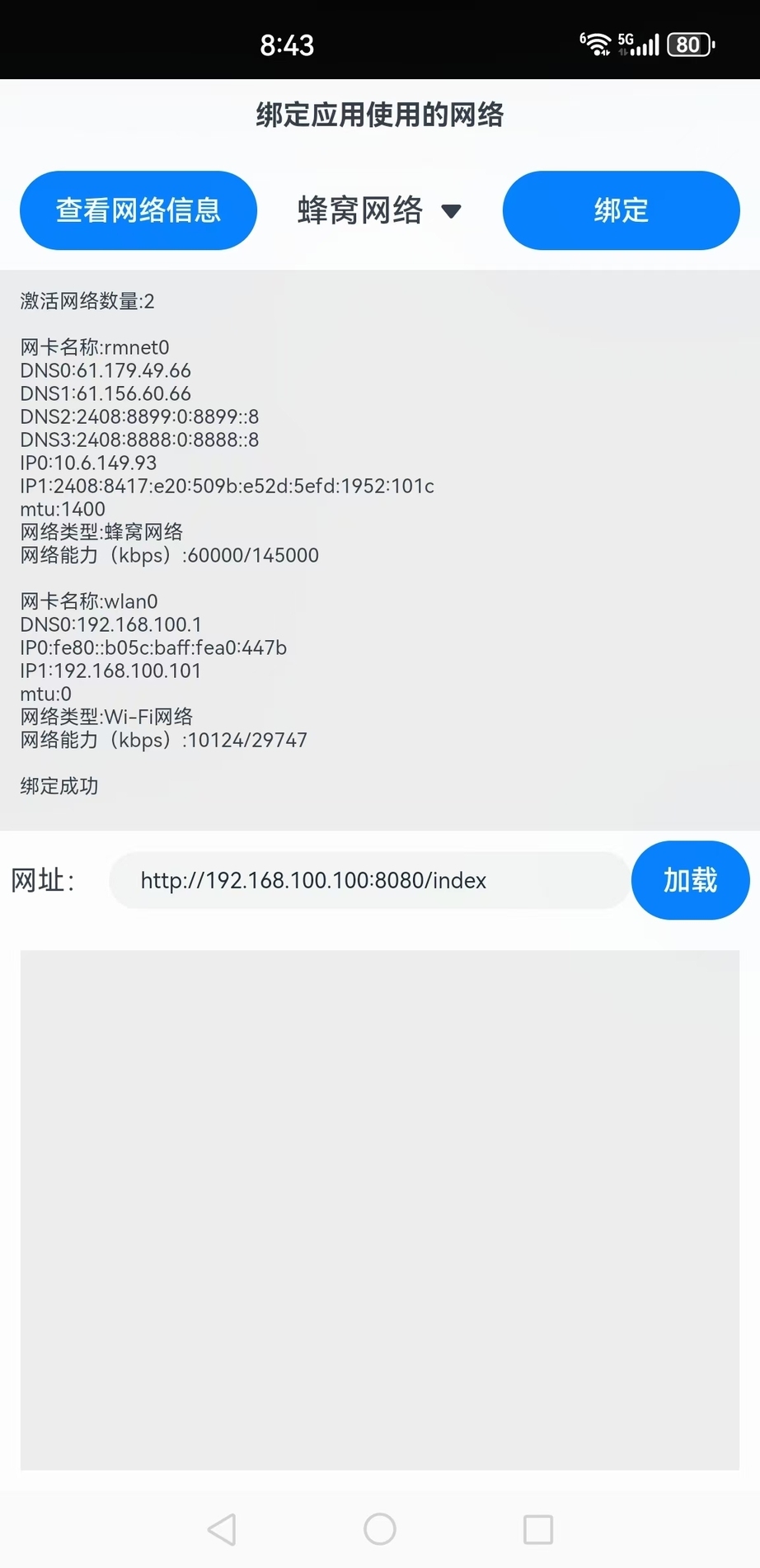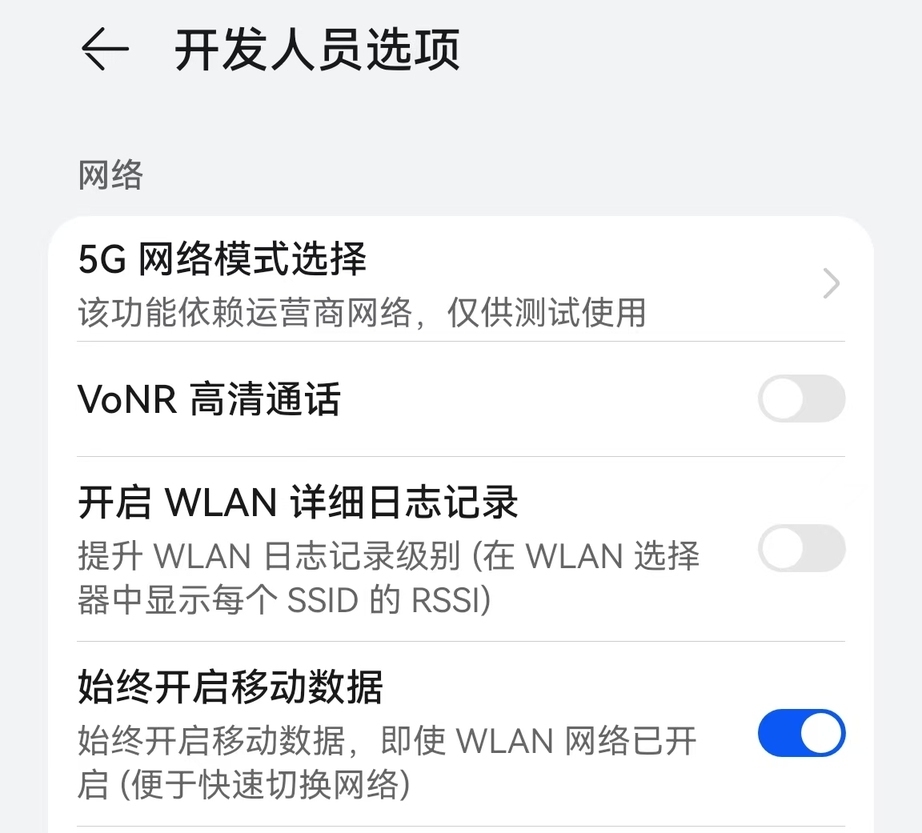1. 网络类型简介
移动设备一般都具备移动网络和无线 WIFI 的连接能力,有些还可以接入有线以太网,这些网络可以根据需要随时切换。鸿蒙 APP 可以自动适应上述的网络,一般来说,会优先使用 WIFI 或者有线以太网,移动网络因为要收费,不会首选使用。但是在某些特殊情形下,可能要求必须使用某一种网络,比如必须使用蜂窝网络,这时候就需要显示的配置一下,指定 app 使用该网络类型。
2. Web 组件及控制器常用方法
网络连接相关能力位于 connection 模块下,使用如下的方式导入:
import connection from '@ohos.net.connection'
复制代码
connection 模块包括了众多的操作方法,就本文而言,重点需要掌握的是如下四个:
1)getAllNets(): Promise<Array>
获取所有处于连接状态的网络列表,使用 Promise 方式作为异步方法。
2)getConnectionProperties(netHandle: NetHandle): Promise
获取 netHandle 对应的网络的连接信息,使用 Promise 方式作为异步方法。
3)getNetCapabilities(netHandle: NetHandle): Promise
获取 netHandle 对应的网络的能力信息,使用 Promise 方式作为异步方法。
4)setAppNet(netHandle: NetHandle): Promise;
绑定 App 到指定网络,绑定后的 App 只能通过指定网络访问外网,使用 Promise 方式作为异步方法。
3. 获取网络连接信息并选择一种绑定到应用
本示例会列出所有激活中的网络,然后可以选择其中一种绑定到当前 APP,最后可以通过访问指定的网页验证是否绑定成功,示例运行后的初始界面如下所示:
下面详细介绍创建该应用的步骤。
步骤 1:创建 Empty Ability 项目。
步骤 2:在 module.json5 配置文件加上对权限的声明:
"requestPermissions": [ { "name": "ohos.permission.GET_NETWORK_INFO" }, { "name": "ohos.permission.INTERNET" } ]
复制代码
这里添加了获取 WIFI 信息以及访问互联网的权限。
步骤 3:在 Index.ets 文件里添加如下的代码:
import connection from '@ohos.net.connection';import web_webview from '@ohos.web.webview'
@Entry@Componentstruct Index { //连接、通讯历史记录 @State msgHistory: string = '' scroller: Scroller = new Scroller() //网络类型列表 @State netShowArray: Array<SelectOption> = new Array<SelectOption>() //网络句柄数组 netHandleArray: Array<connection.NetHandle> = new Array<connection.NetHandle>() //选中的网络序号 selectNetIndx: number = 0 //要测试的网址 @State webUrl: string = "http://192.168.100.100:8080/index" //显示网页的控制器 controller: web_webview.WebviewController = new web_webview.WebviewController()
build() { Row() { Column() { Text("绑定应用使用的网络") .fontSize(14) .fontWeight(FontWeight.Bold) .width('100%') .textAlign(TextAlign.Center) .padding(10)
Flex({ justifyContent: FlexAlign.SpaceBetween, alignItems: ItemAlign.Center }) { Button("查看网络信息") .width(120) .fontSize(14) .flexGrow(0) .onClick(() => { this.ShowNetInfo() })
Select(this.netShowArray) .width(100) .value("选择网络") .flexGrow(1) .onSelect((index, value) => { this.selectNetIndx = index })
Button("绑定") .width(120) .fontSize(14) .flexGrow(0) .onClick(() => { connection.setAppNet(this.netHandleArray[this.selectNetIndx]) .then(() => { this.msgHistory += "绑定成功\r\n" }) .catch((error) => { this.msgHistory += "绑定出错" + error.message + "\r\n" }) }) } .width('100%') .padding(10)
Scroll(this.scroller) { Text(this.msgHistory) .textAlign(TextAlign.Start) .fontSize(10) .padding(10) .width('100%') .backgroundColor(0xeeeeee) } .align(Alignment.Top) .backgroundColor(0xeeeeee) .height(200) .flexGrow(1) .scrollable(ScrollDirection.Vertical) .scrollBar(BarState.On) .scrollBarWidth(20)
Flex({ justifyContent: FlexAlign.Start, alignItems: ItemAlign.Center }) { Text("网址:") .fontSize(14) .width(50) .flexGrow(0)
TextInput({ text: this.webUrl }) .onChange((value) => { this.webUrl = value }) .width(110) .fontSize(11) .flexGrow(1)
Button("加载") .onClick(() => { this.controller.loadUrl(this.webUrl); }) .width(60) .fontSize(14) .flexGrow(0) } .width('100%') .padding(5)
Web({ src: this.webUrl, controller: this.controller }) .padding(10) .width('100%') .backgroundColor(0xeeeeee) .height(200) .flexGrow(1) } .width('100%') .justifyContent(FlexAlign.Start) .height('100%') } .height('100%') }
showConnectionPropInfo(connProp: connection.ConnectionProperties) { this.msgHistory += `网卡名称:${connProp.interfaceName}\r\n` for (let i = 0; i < connProp.dnses.length; i++) { this.msgHistory += `DNS${i}:${connProp.dnses[i].address}\r\n` }
for (let i = 0; i < connProp.linkAddresses.length; i++) { this.msgHistory += `IP${i}:${connProp.linkAddresses[i].address.address}\r\n` }
this.msgHistory += `mtu:${connProp.mtu}\r\n` }
showNetCapInfo(connCap: connection.NetCapabilities) {
let netType = "" if (connCap.bearerTypes[0].valueOf() == 0) { netType = "蜂窝网络" } else if (connCap.bearerTypes[0].valueOf() == 1) { netType = "Wi-Fi网络" } else if (connCap.bearerTypes[0].valueOf() == 3) { netType = "以太网网络" } //添加网络类型到下拉列表 this.netShowArray.push({ value: netType }) this.msgHistory += `网络类型:${netType}\r\n` this.msgHistory += `网络能力(kbps):${connCap.linkUpBandwidthKbps}/${connCap.linkDownBandwidthKbps}\r\n` }
//显示网络信息 async ShowNetInfo() { this.netHandleArray = await connection.getAllNets(); this.msgHistory += `激活网络数量:${this.netHandleArray.length}\r\n\r\n`
//清空下拉列表元素 this.netShowArray.splice(0, this.netShowArray.length);
for (let i = 0; i < this.netHandleArray.length; i++) { let connProp = await connection.getConnectionProperties(this.netHandleArray[i]) this.showConnectionPropInfo(connProp)
let connCap = await connection.getNetCapabilities(this.netHandleArray[i]) this.showNetCapInfo(connCap) this.msgHistory += "\r\n" } }}
复制代码
步骤 4:编译运行,最好使用真机。
步骤 5:单击“查看网络信息”按钮,列出当前网络信息,截图如下所示:
步骤 6:在“选择网络”选择网络类型,比如“蜂窝网络”,然后单击“绑定”按钮,如图所示:
这样就就绑定到了指定的网络。
步骤 7:输入特定的网址,然后单击“加载”按钮既可测试当前绑定的网络。
3. 注意事项
笔者手机默认情况下只有一个激活的网络,可以在开发人员选项下选择“始终开启移动数据”,这样就可以列出多个网络,如图所示:
:
(本文作者原创,除非明确授权禁止转载)
本文源码地址:
https://gitee.com/zl3624/harmonyos_network_samples/tree/master/code/others/SpecifyAppNetworkType
本系列源码地址:
https://gitee.com/zl3624/harmonyos_network_samples














评论